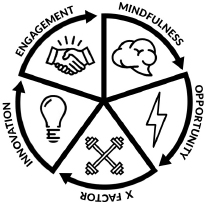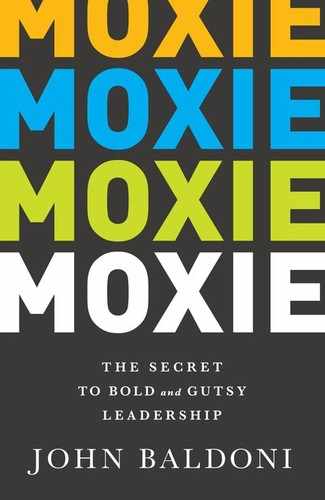Prologue
Give me a place to stand, and a lever long enough, and I will move the world.
ARCHIMEDES
Moxie!
The very word conjures up images of tough-talking guys with bent noses and fedoras pulled down low over their eyes. It is a word that was common in the 1930s and typically associated with people born on the wrong side of the tracks. Common people to whom circumstances had not been kind. They had to make do with what they had, even if it meant using their fists. Prizefighters were said to have moxie, an inner sense of toughness. They knew how to fight as well as how to take a punch. They were tough guys, and the hard knocks they had endured showed on their faces.
Three-quarters of a century later, moxie is not a commonly used word, but it is one that is a favorite of mine. I like to apply it to leaders who have an inner sense of toughness. Most do not come from a hardscrabble or mean-streets background, but all have endured a number of fights, not in the ring nor in places they had to use their fists, but they were punchers all the same. They’re guys and gals who had what it takes to lead others in tough circumstances.
Moxie is the essence of what makes a leader tough on the inside and soft on the outside. These people know what it means to get knocked down, but better still, they know how to get back up. They also stick up for others, especially when the chips are down, and you want them on your side. And lucky for you, they most often are.
By definition, moxie is gumption (get up and go), guts (courage), and determination (perseverance) all rolled into one. These are traits any leader needs, but to me there is another aspect: Moxie was the name of a soda pop, a carbonated soft drink. And so, without stretching too much, you can put a little sugar on the concept, because tough leaders have appeal, a little honey that draws people to them. They are likable.
Why Moxie?
After the financial crash of 2008, we often heard senior executives declare that they’d never seen things so bad. Trust in management plummeted. A survey of senior leaders conducted by Booz Allen in early 2009 showed that 46 percent of those surveyed doubted their CEOs had a credible plan to deal with the crisis, and 50 percent doubted that their company had the leadership necessary to execute such a plan. This lack of confidence did not come from rank-and-file employees, but rather from the senior-most leaders of organizations. That’s pretty damning.
As with most crises, it passed, but its wake left devastation in terms of loss of wealth, jobs, and, frankly, confidence in leaders. Slowly but surely wealth and jobs have been restored—not as much as we’ve hoped—but the trends are positive. Except for those regarding leadership. According to the National Leadership Index for 2012, compiled by the Center for Leadership at Harvard Kennedy School, 69 percent of Americans surveyed viewed leadership in crisis mode. Not unexpectedly, faith in government and corporate officials has eroded over time. But there is hope, because when respondents were asked how America could solve its problems, 81 percent said, “effective leadership.”
Leadership post-crash is not really any different from leadership pre-crash, except for one thing: resilience. Those who have steered their companies back to prosperity did it by making tougher, wiser choices and moving forward in hard times. In short, these leaders have “moxie.”
Flash-forward to the present. In my coaching, I have the privilege of working with men and women at every level in organizations, but as my practice has evolved I’ve begun to focus on those at the top of their game, those who are leading their organizations. They have guts, gumption, and they know how to get glory—for their teams, their companies, and, yes, themselves.
These folks have moxie, and it’s something that every leader would do well to put into practice. I define it as one part courage, one part can-do spirit, and one part recognition. In Moxie, I explore how the concept focuses on what leaders need to be as well as what they need to do. In short, moxie is an acronym … Specifically, leaders need to be mindful of their circumstances as well as of their strengths and shortcomings.

Leaders must be opportunistic in the sense that they want to make positive things happen. They also need to have the disposition to succeed as well as the inner resourcefulness to persevere. Leaders know that risk is involved with most ventures, so they must be willing to do things differently. They must be innovators.
And all good leaders know that they, by themselves, accomplish very little. They must engage with others in order to achieve sustainable goals for themselves, their teams, and their organizations.
Moxie is an attribute that successful leaders use to make a positive difference in the world in which they live.
Leaders with moxie have four key attributes:
Fire. Leaders with moxie burn with a desire to make something happen. They have a passion for what they do, whether it’s building a business or running a small nonprofit. They have a need to make a positive difference in the lives of others.
Drive. Leaders with moxie have ambition. They want to get ahead, and for that reason they will make short-term sacrifices for long-term gains. Their ambition is not all personal. They want others to share in their own good fortune.
Resilience. Leaders with moxie know how to pick themselves up after a fall. They have known defeat, and it does not scare them. It only provides the motivation to get back up and try again, not necessarily the same way.
Street smarts. Leaders with moxie know how the world works. They know how to read people, those who are with them as well as those who may be against them. They have a good sense of what makes people tick and for that reason they are pretty savvy when it comes to making deals.
Speaking realistically, leaders with moxie are those who have the:
- Competence to do their jobs—they are often called “go-to people.”
- Credibility to bring people together—people trust them to do the right job at the right time with the right resources.
- Confidence to believe in themselves as well as in the strengths of others—in short, people feel better being around them.
Put these characteristics together and you have a person who knows himself and what it takes to get ahead. A leader with moxie wants to be in charge. He loves the responsibility that comes with setting the course for others to follow. He is accountable.
A leader with moxie is dependable. She can be counted on to do the right thing and to bring others together for common purpose. She is a straight shooter, and for that reason people like being around her.
We can also look at moxie as a means of dealing with the world at large. Consider moxie as an acronym.
Mindfulness. People with moxie know that good things happen to people who seek them. Such folks are aware of their situation and, most importantly, are aware of their ability to effect positive change.
Definition: A mindful leader knows the situation as well as his capabilities and those of the people around him.
Opportunity. Individuals with moxie do not wait for things to come to them. They look for new opportunities. They are seekers of the new and different.
Definition: An opportunistic leader looks for ways to make things better. She is motivated by a desire to make a positive difference.
X factor. Each of us has a unique set of talents and skills that we use to make our way in the world. More than talent, it is what makes you, you—your character, convictions, and personal beliefs. Consider this set the X factor: what enables you to do what you do and do it well.
Definition: A leader with the X factor has what we call “the right stuff of leadership.” She radiates character and uses her ambition to focus on the right goals. She has the persevering spirit that radiates resolve. Leaders with the X factor are humble, and their humility attracts others to them.
Innovation. Individuals who have moxie are not content with the status quo. They continually seek to acquire new skills and apply them in new ways.
Definition: An innovative leader knows that life is not lived in a linear fashion. Sometimes you need to take risks. That means thinking differently, doing differently, and rewarding others who do the same.
Engagement. People with moxie seek to engage with the wider community. They are focused on making a positive difference in their teams and in their organizations.
Definition: An engaged leader knows that he can achieve little by himself. These leaders engage the talents, but more importantly, the enthusiasm and spirit of others in order to achieve results that enrich, reward, and perpetuate the organization.
Throughout this book you will read interviews with CEOs and thought leaders whose experience in leadership positions gives them the authority to illustrate the attributes of moxie based on their own experience. These interviews, coupled with the stories of the men and women profiled at the head of every chapter, present a portrait of moxie that reveals character, courage, determination, and resilience that are instructive as well as inspiring. My approach in Moxie is to show rather than tell. That is, I want the leaders whom I have selected to present their ideas and insights in ways that will engage your mind, stimulate your innovative spirit, and provide a foundation for continued leadership growth.
Those leaders who put moxie into practice are those who prepare themselves for the constancy of change and set an example for others to follow. Moxie then becomes a principle by which individuals can put their leadership selves into gear in order to accomplish a goal for themselves, their teams, and their organizations. In Moxie, we will see how individuals with moxie at their core succeed.
Leaders with moxie are those to whom others look for guidance as well as inspiration.
Moxie lives!
![]()
